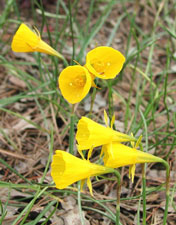Resource Library
Plant of the Week: Petticoat Daffodil, Hoop
The University of Arkansas System Division of Agriculture does not promote, support or recommend plants featured in "Plant of the Week." Please consult your local Extension office for plants suitable for your region.
Plant of the Week
Hoop Petticoat Daffodil
Latin: Narcissus bulbocodium

The intricacies of language both delight and frustrate. One of the biggest frustrations occur when names change; the capitol city of China is no longer Peking but Beijing or Burma no longer exists but is now Myanmar.
Plant names change too, but today a codified set of rules governs the process. Let’s examine the little species daffodil, Narcissus bulbocodium (Hoop Petticoat Daffodil) and see how it got its name.
Hoop petticoat daffodil is a diminutive species growing from sea-level haunts in western France, across much of Spain and Portugal in high mountain meadows to the North African Atlas Mountains in Morocco where it grows at 10,000 feet.
Its small half-inch diameter bulbs produce narrow, rush-like deep green leaves that grow from 6 inches to 12 inches long. In mid spring deep, yellow funnel-shaped flowers an inch or so across are produced individually on scapes reaching 8 inches to 10 inches tall. It’s one the most delicate of the 50 narcissus species that have been described.
We know these common, yellow-flowered garden bulbs as Narcissus because that’s what Theophrastus, the 3rd century Greek scholar, called them in his Enquiry into Plants. The word is a classic Greek word - itself possibly borrowed from a more ancient Iranian tongue - and commemorates a tale of a young man who became so enchanted by his own reflection in a pool of water that the gods transformed him into a flower.
The classic writings of ancient Greek and Roman scholars were saved from destruction during the early Christian era by Muslim scholars who carted whole libraries off to Baghdad.
The first Arabic translations of these works date from about 850 A.D. During the Renaissance, these books were retranslated back into Latin and Greek by western scholars of the 15th and 16th century who used them as the foundation for the emerging study of the natural world.
Classic Greek and Roman writers described plants in their various works, primarily focusing on those useful for treating various ailments.
Without benefit of agreed upon terminology, the identities of many of the plants were obscure, but not Narcissus for they were distinctive enough to be readily identifiable by Renaissance scholars.
But, with so many kinds of Narcissus, what would the different ones be called? As Renaissance scholars wrote their books, they struggled with devising universally accepted names. Wherever possible they preserved names used by the ancient scholars, but these writers only described a few hundred plants from southern Europe. What to call the others?
In the 16th century there evolved a system known as "description names." The little hoop petticoat daffodil was first described in 1581 as "Narcissus montanus iuncifolius minimus alter flore luteo" - a small rush-leaf daffodil from the mountains with a yellow flower.
Descriptive names remained in use until Carl Von Linnaeus (1707-1778) published his Species Plantarium in 1753 and adopted the binomial system of naming. With Linnaeus the hoop petticoat daffodil became Narcissus bulbocodium (the narcissus with a wooly bulb).
Latin names still are the bane to many gardeners but their standardization has been an important step in the advancement of the botanical sciences.
Hoop petticoat daffodil is a small plant suitable for growing in well-drained acidic sites with a good supply of springtime moisture and dry summers. Because of their tiny size, they should be massed together in front of the border locations or in the rock garden. They’re easy to grow in small pots for springtime forcing. They’re not as easy to grow or as vigorous as more common daffodil hybrids, but if they’re planted and left in a location where they’re undisturbed, they will persist for many years.
By: Gerald Klingaman, retired
Extension Horticulturist - Ornamentals
Extension News - February 1, 2008
The University of Arkansas System Division of Agriculture does not maintain lists of retail outlets where these plants can be purchased. Please check your local nursery or other retail outlets to ask about the availability of these plants for your growing area.